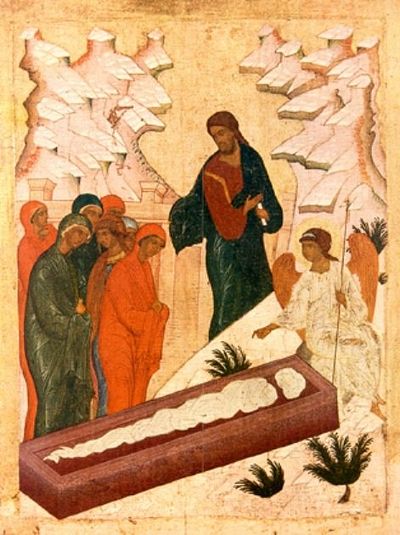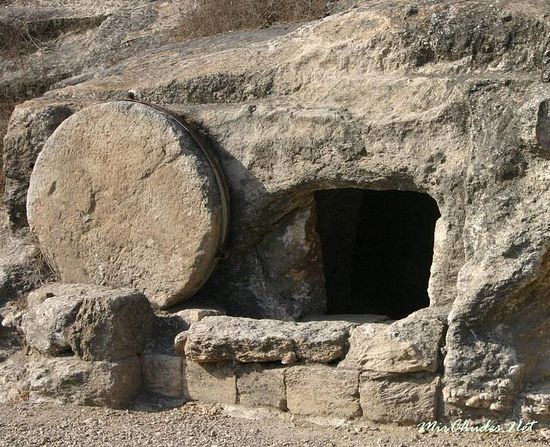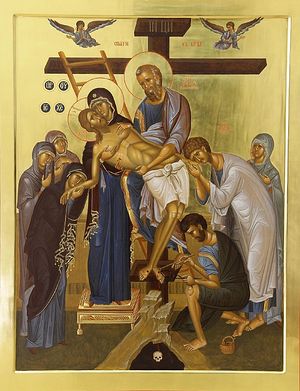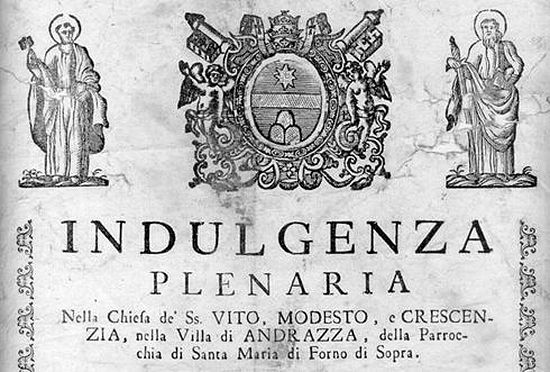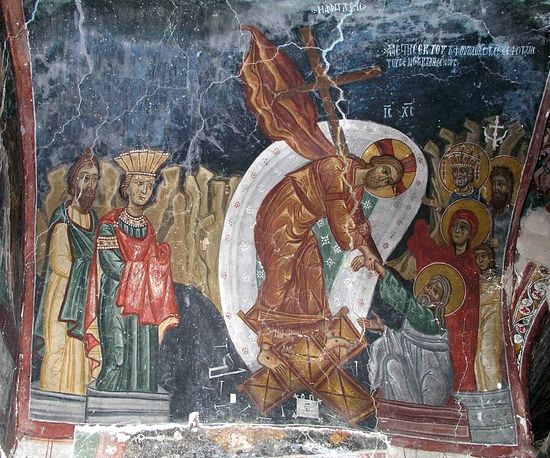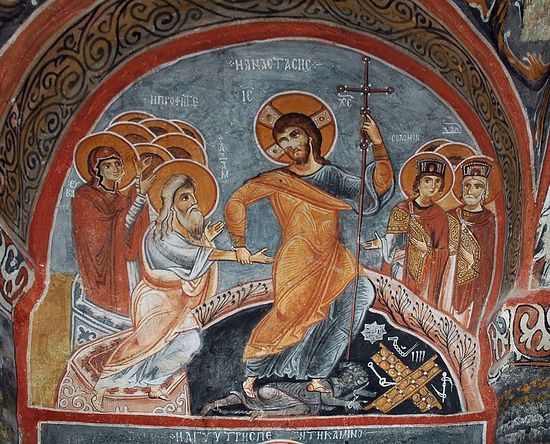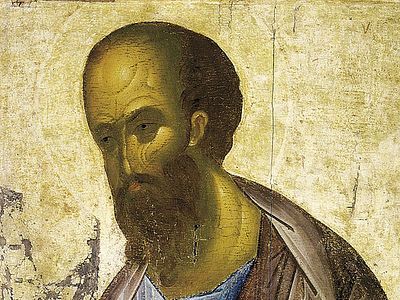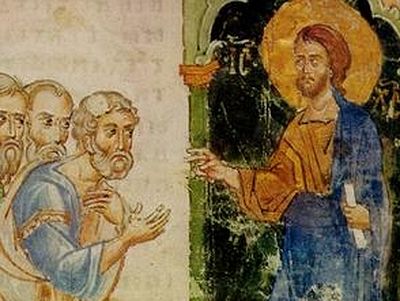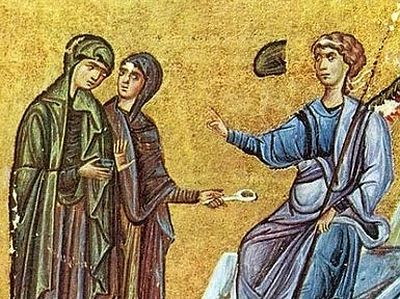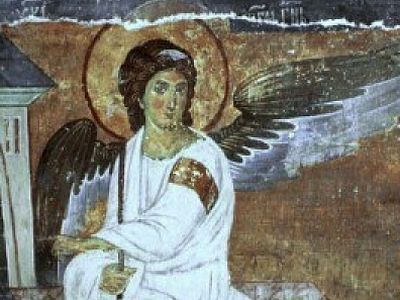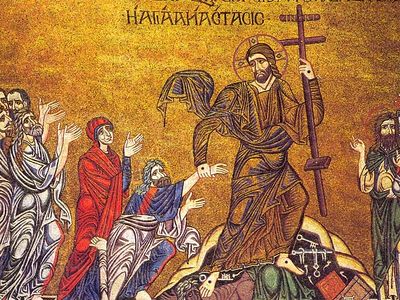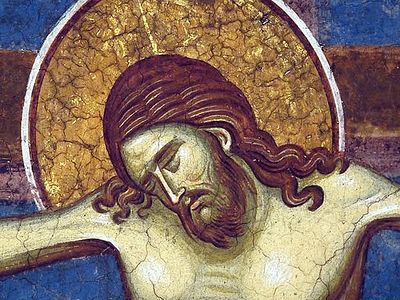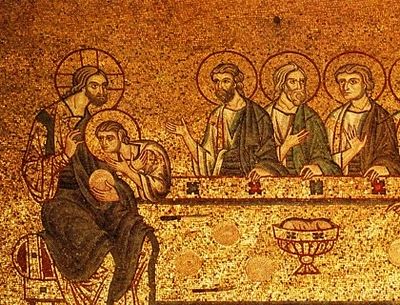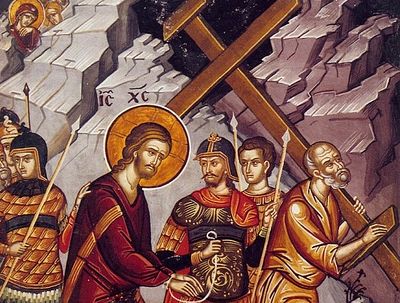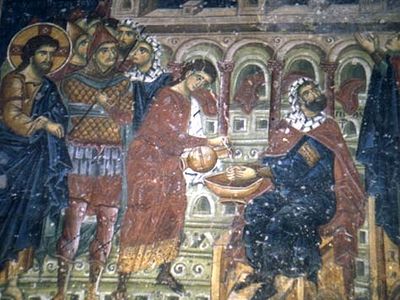See Christ is Risen, Part 3. Rejoice, and Peace!
Today Dr. Jeannie talks about the nature of the resurrected body, the supposed “family tomb of Jesus” excavated in 1980, and the question, “Why did Jesus have to die?”
Christos Anesti! Christ is Risen!
Christ is risen from the dead, trampling down death by death, and upon those in the tombs bestowing life!
The nature of the resurrected body.
Let’s continue with our discussion of the Resurrection, dear brothers and sisters. Let’s begin with the nature of the Resurrected body. As we were saying before, just as Mary was told not to touch Christ because now things were different, Chrysostom makes the same basic point regarding the Resurrection appearance by the Sea of Galilee in John 21, when Christ appears by the seashore and invites the disciples to a breakfast of fish.
In the Gospel of John it says, “no one dared to ask Him any questions,” and Chrysostom says that this is because they no longer felt the same freedom toward Christ. In fact, they did not even begin a conversation with Him, but they ate in silence with respect and reverence. St. John Chrysostom also says that the Lord is recognized when He wishes to be, but hides His identity also when He wishes to. And you will notice this in the account on the road to Emmaus, which is in the Gospel of Luke. It states that initially the disciples, Cleopas and the other disciple, were prevented from recognizing Him. And Chrysostom says the same thing basically about this in the appearance by the Sea of Galilee in John 21. It’s also called the “Sea of Tiberias” there.
So here are Chrysostom’s words about this: “After these things, He manifested Himself to the disciples by the Sea of Tiberias. Do you see that He was not continuously with them as He had been previously? He appeared in the evening and then disappeared. Next, after eight days He appeared once again and again disappeared. Then later He appeared to them at the sea and once more caused great awe. But what is the meaning of ‘He manifested Himself’? From this it is clear that He was not seen unless He permitted it, because henceforth His body was glorious and immortal.”
Here Chrysostom is referring only to the Resurrection appearances in the Gospel of John, and not all of the Resurrection appearances. So, for example, he says that He appeared to them and then disappeared, then 8 days later He appeared again and then by the Sea. This is only in the Gospel of John, along with the appearance to Mary Magdalene, so he’s not suggesting that He didn’t appear at other times, but is only referring to the Gospel of John appearances, because that quotation was taken from Chrysostom’s commentary on John.
St. John Chrysostom also says concerning the appearance of Christ in a body, which showed the marks of the nails and which was capable of being touched by a human hand, the following: This was a “phenomenon, which was evidence of Christ's condescension. To be sure, a body so tenuous and unsubstantial that it entered through doors that were shut was entirely lacking in density. But Christ made His appearance as He did so that the Resurrection would be believed and so that they would know that it was He, the very one who had been crucified, and not someone else who had arisen instead of Him. That is why He arose with the marks of the crucifixion still evident, and it was for this reason that He partook of food.” So there, of course, you’ll again see the Lord showing Himself as He does, not just when He does, and being recognized or not recognized according to what is needed, or allowing Himself to be touched or not allowing Himself to be touched, because it has to do with what each individual needs to learn about the Resurrection. This also has to do with the food. Christ did not need food. When He asks for a piece of fish after the Resurrection, it was to show the physical nature of the Resurrection, and not that He needs food. St. Cyril of Alexandria made the same point in his commentary on John.
So basically, this is a great mystery, dear brothers and sisters. The point is that the resurrected body has certain physical properties. It’s not just a resurrection of the soul, but of the body. It can be touched. Christ can eat in front of the disciples. Yet at the same time, it is not limited by time and space the way we are. It can pass through walls or closed doors, it can appear and disappear instantly, and all of these things account also for the variety of resurrection appearances. So this is the most that we can really say about the resurrected body: that it is truly a body, but somehow spiritualized. It is something that we cannot understand, because Christ alone is the first fruits. He alone has experienced this, and we will have to wait in order to know exactly what kind of body this is. God willing, we shall.
Another myth and hype against Christ’s resurrection.
Now let’s talk about this so-called “discovery” that happened in the Spring of 2007, when claims were made that the family grave of Christ and the bones of Jesus had been found. This was promoted in America on the Discovery Channel. I’m not sure how much it was promoted elsewhere in the world, but there was an Israeli-born director, Jacobovici, who was part of this effort, as was the Hollywood director James Cameron—he is the one who produced the film, “Titanic.” They were hyping this discovery of a supposed family tomb, claiming to have found the bones of Christ and His family members, etc. So let me tell you the truth about that. As usual, there is no truth in it except that there was a tomb with certain names found within it. And of course, first of all, you should not pay attention to these kinds of stories that come out, or the “gospel of Judas.” Obviously, people are intrigued and curious, but Hollywood people and the media are not scholars. They have no expertise in this area. They can’t evaluate these things properly. And, of course, they want to have ratings, they want an audience, they want to make money, so they hype and distort whenever they can; also, because a lot of these people have no faith whatsoever, and frankly, they want to destroy the faith of Christians. They have little regard for Christians, and you can always find someone to make an opinion about something. They’ll find anything they can to try to undermine Christian claims.
So let me tell you the truth about this tomb. First of all, it is not a recent discovery. That tomb was discovered in 1980, and you know there are still discoveries that are made constantly in Israel, any time they build a building. This happens in Athens, too. Very often, when they go to build a building, they excavate and they find ruins underneath and everything has to stop while the archaeologists do their dig and classify things. This happens in Israel all the time. There are actual architectural digs that are done underneath standing buildings. They have learned how to do this. So there are discoveries that continue to be made. But this particular tomb is not a recent discovery. It was found in 1980, and it was thoroughly investigated by archaeologists at the time. And of course, biblical scholars are very involved in archaeology, too. So if there had been any significant discoveries, any kind of a link, a real link to Christ, this would have come out long ago. But there is in fact no evidence to support any link to Jesus at all. And, of course, as I said, Bible scholars are very interested in these things. They would have said something, and you would have heard something about much earlier than the year preceding this podcast.
Now here’s the claim. The basic claim is that it’s the family tomb of Christ, because there are certain names in the tomb that also appear in the New Testament. And that’s basically it. This is all their evidence. I can’t remember all of the names that they mention. They mention James, and we know that there was a stepbrother of Christ whom we call “James, the brother of the Lord,” and Jesus’ name in Hebrew is Yeshua—but that was a very common name. That’s basically the name “Joshua.” Then there’s a name “Mariamni e Mara,” which they try to make into Mary Magdalene, but it’s just too different from Mary Magdalene to be “Mary Magdalene.” But they come up with some kind of an argument and twist things around to try to say that this is really Mary Magdalene. They try to tie it to some village and say that it’s really Mary Mariamna, it is really Mary from this particular village, that it’s really intended to be Magdalene. So they’re really stretching things to try to come up with this proof. But basically their argument is: what are the chances that all of these names, which are so similar to ones in the New Testament, would be found in the same tomb? What are the odds? Well the odds are in fact pretty darn high, because if you look at even the names of the apostles, they have names that are very, very common. There are a million Marys: In the New Testament alone you have Mary the mother of Joseph, Mary the mother of the Lord, Mary Magdalene. There are so many people with the same name. You have three Jameses: James the brother of the Lord, James the greater, James the less. You have two Simons: Simon Peter and Simon the Zealot. So they were very, very common names, and we see this in a lot of cultures. Sometimes people can’t understand that: “Oh, what are the odds?!” Well that’s just a ridiculous argument, because those of us who come from cultures where certain names are common understand this perfectly well. In America today, when people have a baby—I’m talking about the Americans, the general public—they usually want to give the baby some kind of an unusual name. But that’s not the custom in most of the world including in the Middle East, in Greece, in places like that. In any given community, just in the Greek community, for example, you have lots of Dimitriis, Georges, Elenies, Marias, Nicholases and Constantines. And people, especially those who come from a particular village or a particular island, will very often have the same name. Sometimes you can tell right away what part of Greece someone came from by their name—by their first name. So this argument that “what are the odds that these names that are found in the New Testament would be in this one tomb?” is just so weak. It’s just not an argument, because these were extremely common names that Jewish people had who lived in Palestine at the time—so it is not a good argument. But that’s their strongest argument that this is the family tomb of Christ. So, it’s almost not even worth discussing, and to Biblical scholars this story was a “ho-hum.” Nobody paid any attention to this story despite the fact that it was hyped so much in the media.
Let me give you a few other reasons why this could not have been the family tomb of Christ. First of all, this tomb was four miles south of Jerusalem. That doesn’t sound very far to us because we drive around in cars, and four miles is nothing to us. But Bethany, where Lazarus died, was two miles outside of Jerusalem. That’s a separate town from Jerusalem. This tomb is twice is far. We know that the Lord had to be buried very quickly on a Friday afternoon, because the Sabbath was about to begin. I can assure you, they would not have carried Him four miles to bury Him in a particular tomb. Also, the description of this tomb does not match the Gospels. This tomb had a large square stone that was wedged into the entrance of the tomb to close it. And we know on the other hand that the Gospels say consistently that Jesus’ tomb had a large round stone blocking the entrance. That was more typical. That stone had to be rolled away to create an entry into the tomb. We also know from the Gospels that the tomb for Christ’s burial was provided by Joseph of Arimathea, who was a wealthy man, because they needed a tomb in a hurry. But also, these types of tombs, types that were hewn out of rock, were not the norm for poor family. Christ did not come from a family of means, so it’s highly unlikely that He had a family tomb like this, hewn out of solid rock—so that’s very unlikely. And finally, if there were a family tomb for Christ’s family, it would have been in Galilee, not in Jerusalem, because Christ was not from Jerusalem. Christ’s family was not from Jerusalem, and Galilee is about 100 miles north of Jerusalem—so there you have it. There’s basically no evidence to support tying this tomb to Christ—but they want to undermine the Resurrection, so what can I say?
Why did Jesus have to die?
I told you last time that I was going to address a particular question that had been posed by a listener to this podcast. This was the question: Why did Jesus have to die at all? Why couldn’t God simply have forgiven us? Now this listener is a catechumen and he told me that he was having some trouble understanding this Christian doctrine, because he was coming into the Church having been a Muslim. So he is truly trying to learn basic doctrine, and I thought it was an excellent question. I have to say that I thought that this is the type of question that sometimes needs to be addressed, just as I was talking in the first podcast about the Resurrection—why it was important; even though that’s a very basic question. Sometimes we need to discuss these basic questions, and I don’t always think of them. I don’t often think of some of the most basic questions that need to be addressed. That’s why I do encourage you to ask me your questions so that I can address these things that I presume we all understand.
So the question of why Christ died at all is not actually a question about the crucifixion. At first I thought that perhaps I shouldn’t address this, because we finished the crucifixion. But then the more I thought about how I would answer that question, the more I realized that the question is about the Resurrection—and so I’m going to discuss this. And you will see why it’s really a question about the Resurrection.
The Orthodox understanding vs. the Western juridical model
First of all, I’m not going to address the question of Jesus having to die voluntarily. We already discussed that, and I don’t think the listener meant it that way—that it was not a voluntary death. But the way the listener phrased the question, “Why did Jesus have to die? Why couldn’t God just forgive us without the death of Christ?” suggests to me that his understanding of Christian doctrine arises out of a Western context, a Western understanding that focuses on the death of Christ as atonement for sin, that Christ paid the penalty for our sins. We have to be careful, as Orthodox Christians living as a minority in the West. If you’re listening to me in English you are probably living in a Western country, and obviously a non-Orthodox country; and we have a tendency to absorb these kinds of concepts because we are listening to Christians of other denominations and confessions talking all around us. The idea of Christ dying “to pay the penalty for our sins” is a primary focus in the West on the crucifixion of Christ. Now, Christ’s death as atonement is not incorrect, because the idea of Christ’s death as sacrifice is in the Bible. We cannot deny that Christ’s death is atonement for sins; but the question is, in what manner is that understood? The “atonement” in the West is very often interpreted as a “quid pro quo—that means “this for that.” This understanding of the atonement, which is still the dominant concept of understanding the death of Christ in the West, was developed during the Middle Ages. They developed an understanding of the death of Christ according to a juridical model—that means a legal model. They came to understand the death of Christ as involving a payment for the penalty of sin as part of the justice of God. So it’s a model based on crime, punishment, justice, etc. Now this, of course, was developed long after the original understanding of the meaning of the death of Christ, which is very ancient. Western thought was influenced very much by reason. So not only is there the development of scholastic theology in the West—and this means that they applied reason and then developed their theology based on rational thinking—not only they had that, but also Western thought was very much influenced by Roman law, and this was also significantly expanded and developed during the Middle Ages.
I get this information from Roman Catholic sources, not Orthodox ones. I personally think that if you are interested in finding a book that explains Roman Catholic thought, Roman Catholic doctrine, probably the best and the easiest is a two volume set called simply “Catholicism,” by Richard McBrien. Two big volumes, but it’s very good because he explains the development of Roman Catholic thought, and he explains that during the Middle Ages there were new theological trends set in the monasteries. One of the most important people in this regard in our discussion is Anselm of Canterbury, who died in 1109. He is the one who introduced the “satisfaction theory” of atonement. He’s the one that introduced the concept that sin is an “offence” against God that demands payment, or “satisfaction.” This was new, and was an idea that is very alien to the Church. We don’t think of sin as something that requires some kind of “payment.” This kind of mentality was fused with concepts in Roman law. We do not employ legal terminology in theology, and even in canon law we don’t use legal terms. We don’t conceptualize theology in terms of legal categories, legal classifications, terminologies, etc. We do not think of sin, for example, as an offence against God that requires some kind of punishment or restitution, but primarily as a failure or an illness, which needs healing.
Now to be fair, the Catholic statements, especially since Vatican II, made an attempt to recover this view and also describe sin as an illness, as a breach in the relationship with God. Vatican II is the most recent ecumenical council of the Catholic Church. It was held in the early 1960s, and that was the council at which the Catholic Church modernized and made many, many dramatic changes. Even though there were big decisions made at Vatican II, many Catholic practices, statements, teachings still continued unchanged, so you still have within the Catholic Church a strong juridical or “legal” understanding of sin. It’s not as strong as it once was, that’s for sure, and I don’t mean to over exaggerate, but it’s still there. The legal understanding of sin which requires punishment is still strong. And I’m getting to why the Crucifixion and understanding it is tied to Resurrection. But I want you to understand this, because I think it’s very important that the Orthodox and Catholics understand each others’ way of thinking.
So I will get to the answer to the question; but basically, what I’m trying to get across to you is that this legal understanding of sin is still part of Catholic thought. And you can see how this is still reflected in things such as their doctrine of Purgatory, which is still Catholic teaching. Catholics don’t talk about it a lot, but it is still official Catholic teaching—and the Vatican continues to offer indulgences. You may not be aware of this, but indulgences are still part of Catholicism. Indulgences are offered because Catholicism holds that the guilt of a sin may be forgiven in confession, but not the punishment which sin requires. We don’t make that kind of distinction. We can’t imagine that your guilt can be forgiven, but not the punishment. But that’s not Catholic doctrine, and that’s why the doctrine of purgatory is necessary for them. If you really examine this, you’ll see that there’s a fundamentally different conception of what sin is and how sin is forgiven—do you see that? Because if you’re saying there’s a purgatory, that it is necessary even if you have repented of a sin in confession, then you have a very different understanding of sin, don’t you? And the understanding of the relationship between God and the human being then is very different too, because it’s as though God says, “Well, I forgive you, but you still have to be punished.
About indulgences.
Now about indulgences. These are not the kind of indulgences that Martin Luther was protesting against. They’re not selling indulgences; but still, the popes periodically offer indulgences. An indulgence is basically “time off” from purgatory. They say that indulgences diminish the time spent in purgatory suffering for minor sins, or what they call “venial sins.” Pope Paul VI, who was pope not very long ago, wrote a message, a statement called, “Indulgentiarum Doctrina,” or, the “Doctrine of Indulgences”, and this is what he said. This is a very high-ranking papal document: “It is a divinely revealed truth that sins bring punishments inflicted by God’s sanctity and justice. These must be expiated either on this Earth through the sorrows, miseries and calamities of this life and above all through death, or else in the life beyond, through fire and torments or purifying punishments. These punishments are imposed by the just and merciful judgment of God for the purification of souls, the defense of the sanctity of the moral order and the restoration of the glory of God to its full majesty. That punishment or the vestiges of sin may remain to be expiated or cleansed and that they in fact frequently do even after the remission of guilt, is clearly demonstrated by the doctrine on purgatory…” (emphasis by Dr. Jeannie in italics).
So you see, the idea is that they make a distinction between being forgiven of a sin and having to not suffer for this sin. So you still suffer for the sin. What he’s saying is that sin “disrupts the moral order” and the “majesty of God” and you have to pay the consequences of your sin. The penal consequence remains, but the guilt is forgiven, and it requires purification. So I’ve already said that this is extremely different from our teaching on sin and forgiveness. It’s impossible to ever imagine that there’s anything we could do to “diminish the glory” or “the majesty” of God. And, of course, forgiveness is always complete. The person is restored to wholeness and there’s no conception that anything else is necessary.
Now the same kind of legal understanding of sin, at least as it relates to the crucifixion of Christ, is also found in Protestantism. The emphasis that Christ’s death on the cross was “to pay the penalty for sin” is very much present in Protestantism, because Protestantism appeared after these ideas were developed in Catholic theology.
So what I’m trying to show you is that this question posed by the listener is very legalistic in its frame, and this shows that he has learned something about the death of Christ from Western thought. These concepts are still present in the mentality of the West. This view of salvation, which is very legalistic, now in post-Vatican II Catholicism feels too legalistic even for some Catholics and suggests a different kind of relationship between human beings and God. The emphasis is still placed very much in the West on the death of Christ, an emphasis on the suffering of Christ, the suffering of Mary, the need for Christ to pay the penalty for sin, that we benefit directly from His suffering through the “merits” of Christ. This is another concept in Catholicism that’s completely absent in the Orthodox Church. It is a very, very different conception of sin. There is no such concept of benefiting from Christ’s suffering in any kind of a “quid pro quo” fashion.
Christ’s suffering as an example of His extreme condescension and love.
The suffering of Christ is an example of His humility, His condescension, His great love for mankind. Catholics and Protestants would certainly agree with this, but it’s unquestionable that they focus to a significant extent on Christ’s suffering itself and the death of Christ itself as a kind of atonement for sins.
So let’s return to the question: Why did Jesus die? Let’s start with that. He died in order to destroy death. That’s why this question is really about the Resurrection. Christ did not die “to pay the penalty for our sin.” He did not die because God the Father expected some kind of restoration or payment for sin. He died because the consequence of sin is death. So let’s talk about that. Why is the consequence of sin death? Not because God demands payment, justice, penalty etc. The consequence of sin is death because God is life, and when we turn away from God and disobey Him, we are turning away from life and toward death. Now among the Fathers there is much more discussion about the importance of the Incarnation for the salvation of mankind than the crucifixion. And salvation through the Crucifixion is, of course, entirely due to the Resurrection, and not to any atonement theory. So through the Incarnation and the Resurrection, Christ restores our nature, which had been marred by sin, uniting the human nature with the Divine, elevating the human nature, etc.
So even though, as I said, the Catholic Church in more recent years has returned to these kinds of statements, they still have the atonement concept, so that concept has never really been left behind. Thus, if you were to ask a Catholic or a Protestant why Christ died, they’re not going to say, “to conquer death.” They’re going to say, “to pay for our sins.” I’m not sure what an Orthodox Christian would say; we have to find out, especially those of us in the West—and like I’ve said, we’re influenced by those ideas. We have to be careful to know our own tradition. Again, I’m not saying these things with the intent of criticizing. I want the Orthodox to understand. I’m saying it’s important for us to understand others’ traditions. Thus, Christ “had to” die to destroy the power of death by rising from the dead. In order to destroy death, He had to die and then conquer death. And this is why we say, “He trampled down death by death,” in the hymn of the Resurrection. We also say in the hymn, “Only-begotten Son and immortal Word of God,” that, “He conquered death by His own death.” It’s a very powerful image: He stomped on death. He conquered death. So there is the question again: Why did Jesus have to die? Why couldn’t God just forgive us? It’s not that God couldn’t forgive us. The Cross is not suffering as penalty for sins, but the Cross is life and Resurrection. “Your Cross, O Christ, is life and Resurrection.” He suffered for our sakes, not to pay any kind of penalty for our sins, but to restore our fallen nature due to the effects of the ancestral sin, the Fall of mankind. Just as Adam fell due to his disobedience and the result of that was death, Christ as the New Adam is obedient to God, and the result of that is life and the restoration of our relationship with God. So Christ is the new Adam, not because He has paid penalty for Adam’s sin, but because He restores human nature. And again, I don’t think that Catholics or Protestants would necessarily disagree with this. What I’m saying is that it is a question of emphasis. So when you look at the hymns even of Great and Holy Thursday and Friday, where you would expect, if you were thinking of atonement, to find this kind of language, you won’t find it. The hymns are talking about the Cross, but there are references to the “removal of the ancient curse,” the “restoration of Adam and Eve,” etc. We don’t deny the reality of Christ’s sacrifice, but it was not done to “pay a penalty for our sins” or so that we might somehow “benefit” from His suffering.
Now for the concept of sacrifice in general, animal sacrifice in general, what sacrifice has to do with sin, why God required that of the Israelites—I will leave that for our introductory course when we discuss the book of Leviticus. We will come back to the question of sacrifice.
Now perhaps this is a good time to discuss the icon of the Resurrection. What do we see in the icon of the Resurrection? We see the same kinds of things. Sometimes, however, Christ is turned sideways and sometimes He’s sort of “facing the camera,” if you will. You can see His body frontally, and other times He’s turning to the side, but in both instances we see Adam and Even being lifted up by the outstretched hand of Christ. Sometimes it shows only Adam, but usually it’s both. I think in the icon where the Lord is turned sideways, He seems to be compassionately lifting up Adam with His outstretched hand. But the other one, where He’s facing forward and is looking directly at you, is a very interesting icon. It’s a very dynamic icon. He’s pulling up Adam and Eve out of their graves. He has taken one with the right hand, another with the left. His feet are spread apart in a very powerful stance. Now under His feet you will see something that looks like a cross, but it’s not a cross. There are two very wide pieces of wood crisscrossed with each other. Those are the broken gates of Hades—because He broke the bars and the gates of Hades. And underneath that, very often, there’s a black area, and you will see keys scattered and opened locks, locks in the open position, to show that Christ by His Resurrection released the souls that had been held captive. Also sometimes underneath you will see something that looks like a man lying down, and he’s all tied up. He’s bound up, and that is death, or Hades personified.
So this is a good place to stop for now. In the next lesson, I promise, we will discuss the oldest written account of the Resurrection of Christ. I mentioned this in the first podcast of this series and I wonder if you have figured out yet where it can be found. As I said, it’s not in the Gospels! We’ll talk about it next time. Let’s see if you have discovered it.
Let’s have our closing prayer; but in case you’re wondering, the little response I give after the prayer is not the response that we give to the greeting or the exclamation “Christ is Risen!” When we say, “Christ is Risen!” we simply say in response “Truly He is Risen!” But if it’s the hymn of the Resurrection as a prayer: “Christ is Risen from the dead, trampling down death by death… etc.”, then we respond, “Truly the Lord is Risen!”—“Alithos Anesti o Kyrios!” At this time of year it is typical of the priest not to say the usual ending for a service. That usual ending, “Through the prayers of our Holy Fathers, Lord Jesus Christ our God, etc.” Instead of that, the priest says, “Christ is risen from the dead trampling down death by death…” He says this as a prayer, as a closing statement for the liturgy. Then you are supposed to say, “Truly the Lord is Risen!”, “Alithos Anesti o Kyrios.” So if you belong to a choir or are a chanter, don’t end with “amen.” We don’t say “amen” to “Christ is Risen from the dead trampling down death by death…” We don’t respond with “amen.” Instead we say, “Truly the Lord is Risen!” So now let’s close with our prayer, and you can say the response with me.
Christ is Risen from the dead trampling down death by death and upon those in the tombs bestowing life. Truly the Lord is Risen! Alithos Anesti o Kyrios! God bless you all.
Presbytera and Dr. Jeannie Constantinou’s podcasts can be found here.
